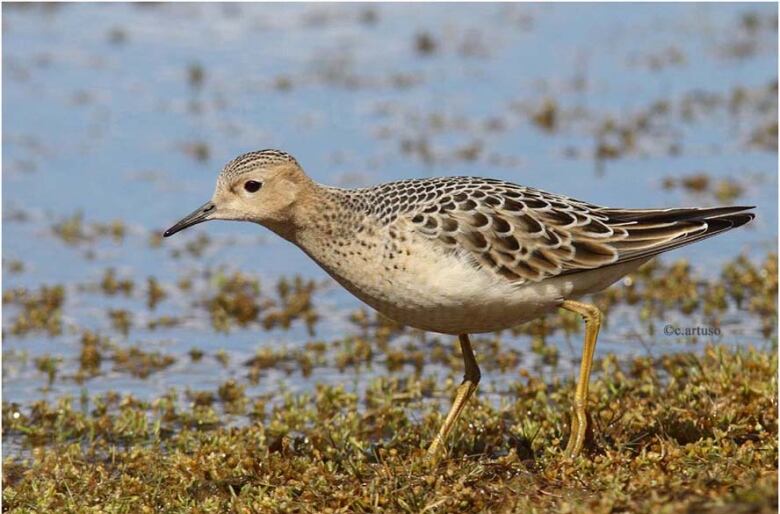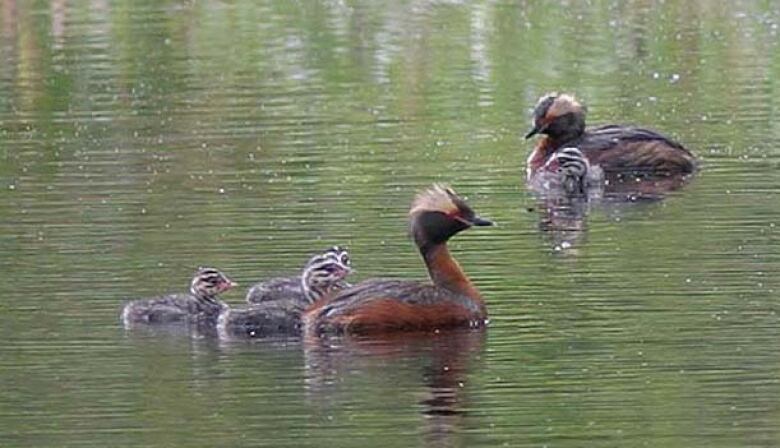3 Manitoba birds listed as national species at risk
Baird's sparrow, horned grebe, buff-breasted now 'species of special concern' under Species at Risk Act

The deteriorating stateof three Manitoba bird species has caughtthe federal government's attention, and it comes as a welcome changefor some inthe wildlife world who have been waiting for the additions for several years.
"We were hoping that it was inevitable that they would pass," said biologistChristian Artuso with Bird Studies Canada. "It's just that under the previous government these things seemed to get stalled out."
The Baird's sparrow, the horned grebe and the buff-breasted sandpiper were listed as species of special concern in June underthe Species at Risk Act (SARA). Eight other wildlife species in other provinces were also added, while a handful ofothers that were already on the list received newdesignations.
The additions stem fromrecommendations made by theCommittee on the Status of Endangered Wildlife in Canada (COSEWIC) over the past fewyears. The organizationis made up of a group of wildlife experts who monitor speciesthatarefacing challenges staying alive in Canada.
COSEWIC makes these kinds of recommendations regularly. In an ideal world, Ottawa listens to those suggestions, which triggers the need for theCanadian Wildlife Service tocomeup with one-to-three year managementstrategies, depending on the status of the species,CWS species at risk biologist Ron Bazin said.
That hasn't exactly happened as planned recently; recommendations piled up under the Harper government.
Horned Grebe (western population) now a listed species in Canada. See their distribution in #MB https://t.co/WPSf3j8pmI
—@cpawsmbOf the three Manitoba species, this backlog is best illustrated bythe horned grebe, a wetland waterbird. It wasassessed as a species ofspecial concern by COSEWICmore than sevenyears ago and was finallyclassified as suchby the federal government this spring.
"It took from 2009 until now to get them [horned grebe] moved from the COSEWIC recommendation into the SARA," Artuso said.
Bazinsaid he anticipates the current administration will work to get more of those recommendations pushed through.
Baird's 'in trouble'
Artusohas spent parts of thisspring and summer as he usually does;rising with the sun, before the melodic chirping of thedawn chorus gets underway, to seek out birds that aren't faring well in Manitoba grasslands.
He was in the field last week looking for Baird's sparrowsdays after the announcement from Ottawa that it was among 11 species listed as at risk atthe federal level.
During that outing southwest of St. Lazare, Man., at theEllice-Archiecommunity pasture, he came acrossa bunch of Sprague'spipitsand chestnut-collaredlongspurs, both of which are classified as threatened provincially, federally and internationally.
Artusowas surprised to find four Baird's sparrows flitting about the same bucolic Prairie pasturealong the Saskatchewan-Manitoba borderlast summersomewhere the diminutive drab birds are seldom seen, at least these days.
"Baird's sparrow has been on the radar for a long time as a grassland bird that is in trouble and is very limited in its distribution in Manitoba, sadly,"Artusosaid.

To revisit the area this summer and not find those birds, or a single Baird's for that matter, seemed to align better with what bird scientists likeArtusohave come to expect of the species in Manitoba.
Most of the province's Baird's sparrows are isolated to a tiny island of native mixed grass Prairie in the southwest in what's been designated an Important Bird Area.
"Historically they probably were a lot more common in Manitoba, but with the loss of native Prairie, you just don't have [the habitat]," Bazin added.

All three grassland songbirds the Baird's, the longspur and the pipitare for the most part only found west ofBrandon, Man., these days. Historically, that wasn't the case. As early as the1980s, the chestnut collaredlongspurin particular could be foundbreeding in St. James in Winnipeg.
"Like most things that formerly occupied the whole of the greater Prairie ecosystem east to Winnipeg, and to where the Prairie meets the boreal transition, they've basically lost all of that central southern Manitoba range,"Artusosaid."There's just not any good large open tracts of Prairie left; it's all converted to agriculture."
'Given the attention they deserve'
The Baird's sparrow is endangered provincially, and despite the comparatively less severe federaldesignation "of special concern" Artuso said as a conservationist, he's cautiously optimisticwith what he's seen from the Trudeau government thus far.

Anyone hoping to catch a glimpse of one of these birds out in the wild is best off heading to one of Manitoba's 38 Important Bird Areas.Artusohas spotted high numbers of buff-breasted sandpipers during fall migration atOak Hammock Marsh, Whitewater Lake and on the Seal River north of Churchill, Man.
LikeArtuso,Bazinspends his days focused on the plight of Manitoba's birds. When it comes down to why ordinary people should be concerned about how thebirds are doing,Bazinsaid he finds himself repeating a familiar refrainin his field:
"It's the whole aspect ofbiodiversity. They are a part of the ecosystem. You don't know what you've lost until you've lost it."













_(720p).jpg)


 OFFICIAL HD MUSIC VIDEO.jpg)
.jpg)



























































































